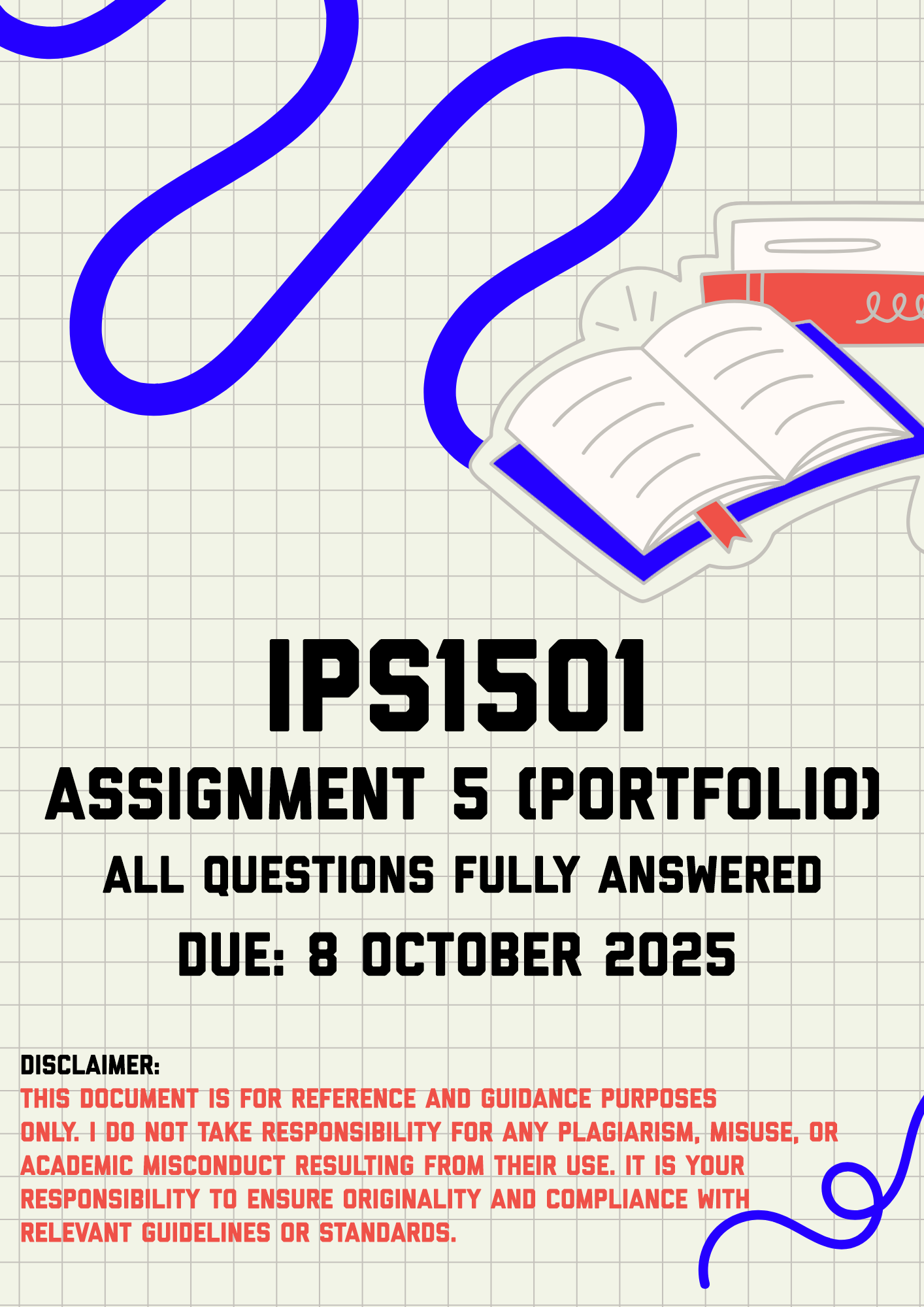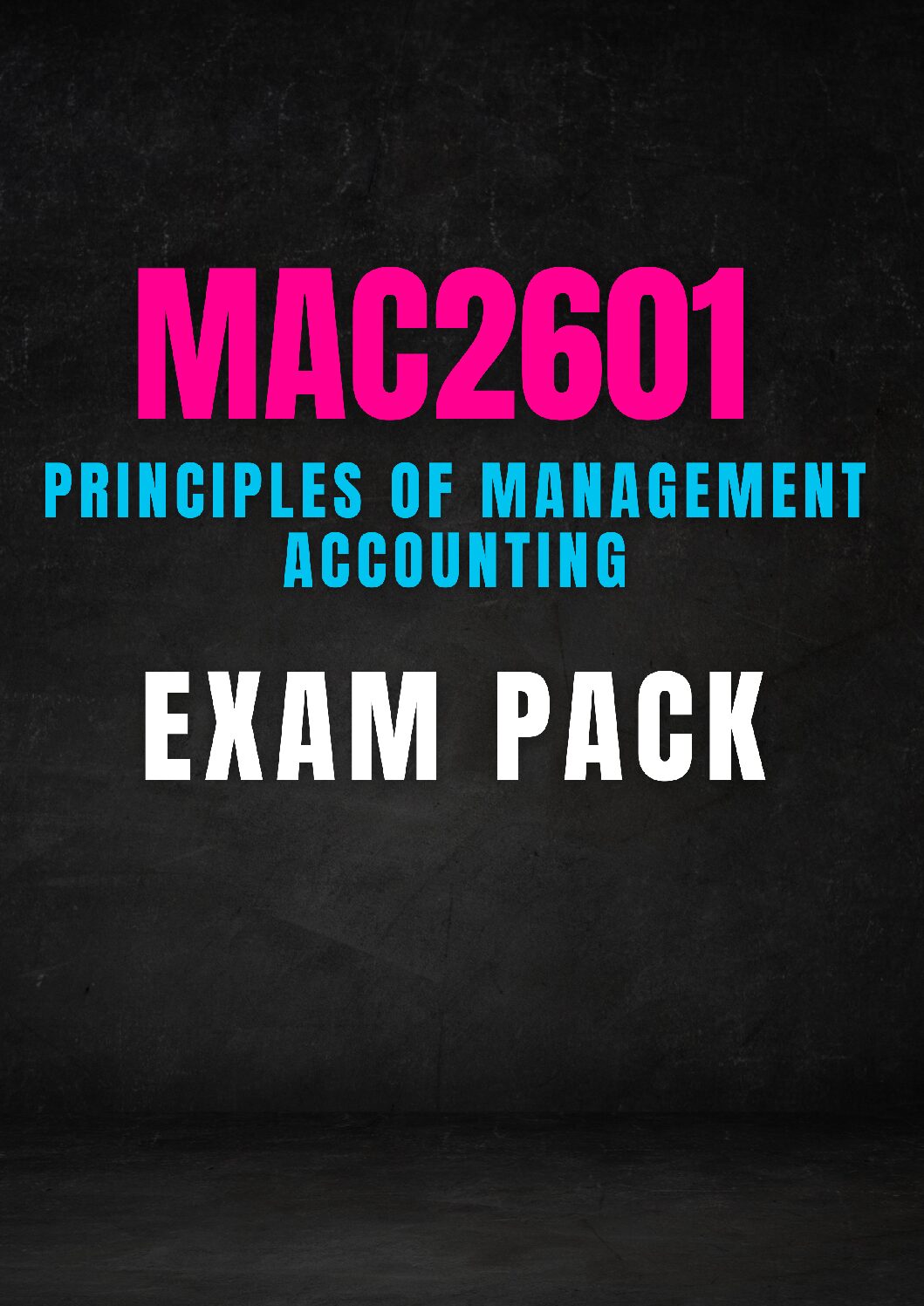Description
IPS1501 Assignment 5 (Portfolio) Memo | Due 8 October 2025. All questions fully answered. Question 1: Defining Life Skills (25 marks) Read the definitions of Life Skills from Jordaan & Naude (2018) in your IPS1501 study guide. 1.1 Identify at least FOUR (4) key ideas in the given definitions. (4) 1.2 Explain the meaning of each of the four key ideas, that you have identified, in your own words, to show your understanding of them. (4) 1.3 Draw a table in which to answer the following two questions. (3 + 3 = 6) 1.3.1 Identify and discuss at least THREE (3) demands, or challenges, of everyday life that are unique to your own life and circumstances. (3) 1.3.2 Discuss at least ONE (1) life skill that you use, or could use, to overcome each demand, or challenge of everyday life you have identified in question 1.3.1. (3) Example of table to answer questions 1.3.1 and 1.3.2 1.3.1 Demands/challenges in my OWN life 1.3.2 Life skills that I use or need to overcome these demands or challenges a. b. c. 1.4 Draw a table in which to answer the following two questions. (3 + 3 = 6) 1.4.1 Identify and discuss at least THREE (3) everyday life demands (challenges) that may be experienced by intermediate phase learners in South Africa. (3) 1.4.2 Identify at least ONE (1) life skill for each of the everyday life demands (challenges) that you identified in Question 1.4.1 (one different life skill for each demand, do not duplicate life skills). (3) Example of table to answer questions 1.4.1 and 1.4.2 1.4.1 Demands/challenges in the lives of learners in the intermediate phase 1.4.2 Life skills that learners in the intermediate phase need, to overcome these demands or challenges a. b. c. 1.5 Read the description of the school subject Life Skills in the CAPS document for the Intermediate Phase (Department of Basic Education, 2011) and name the five areas of potential that are considered important for the holistic development of the intermediate learner. (5) [25] Question 2 : Concepts (10 marks) 2.1 Read up about Bowlby’s Attachment Theory and explain what it means. Use your own words (paraphrase) to show that you understand the concept. You will be penalised if you copy directly from the study guide or internet sources. (4) 2.2 Provide a correct reference for the source of your information, according to the Harvard referencing style. (1) 2.3 Share an appropriate example of a positive attachment figure, either from your personal or school experience, or from a situation you have observed. (2) 2.4 Explain how knowledge about Attachment Theory can enable a teacher to 6 be more effective. Give an example to support your answer. (2 marks for explanation + 1 mark for example) (3) [10] Question 3: Case study (15 marks) Read the case study and answer the questions that follow: Lesego is nine years old and in Grade 3. His teacher notices that he struggles to cope with some academic demands, which can result in feelings of inferiority. Lesego’s greatest fear is to do a presentation in front of the class. The teacher realises that, if she helps him to do certain tasks, he may soon learn to execute the tasks independently. The teacher decides to design learning steps for Lesego, with the end goal of him being able to do a presentation in front of the class. She invites him to write one short presentation every day, consisting of just two sentences. During break, when all the children have left the class, he stands and, while looking at the empty chairs, he recites the two sentences. After a week, Lesego is ready and invites his best friend to listen to his speech. The teacher teaches him to make eye contact with his friend and to ensure that his hands are still, while he speaks. She also teaches him to talk silently (to himself) before he gets up to do a speech, so that he remains calm. After a week Lesego is ready to do a short presentation in front of the class. He gets up and bravely walks to the front. The teacher can see his lips move and realises that he is talking to himself to calm himself down. He then looks at the class and, while keeping his hands still, he delivers his first ever presentation in front of the class. Afterwards, Lesego is extremely happy. The teacher observes that he takes on more tasks in the classroom and also takes part in class debates. 3.1 Identify and discuss the stage of Erikson’s psychosocial theory in which Lesego may be placed. (1 mark for identification + 4 marks for discussion) (5) 3.2 The teacher realises that Lesego needs assistance with tasks, which he is unable to perform on his own. If she helps him now, he will be able to perform them without help in future. Refer to Vygotsky’s theory and state what this intervention is an example of. (2) 3.3 The teacher designed steps for Lesego to overcome his fear of public speaking. By referring to Vygotsky’s theory, state what this intervention is an example of. (1) 3.4 The teacher taught Lesego to talk silently to himself. Refer to Vygotsky’s theory and state what this intervention is an example of. Complete this sentence: Lesego helped himself by… (1) 3.5 Will the help that the teacher gave Lesego, assist him with other schoolwork? Give a reason for your answer. (2) 3.6 Lesego managed to take part in class debates. Of what, according to Erikson’s psychosocial theory, is this a sign? (1) 3.7 Read page 10 in your study guide for IPS1501. Considering the views of Broderick and Blewitt (2015:11), write down THREE (3) characteristics that Life Skills and other teachers should have, to enable their learners to move successfully through the different stages according to Erikson’s psychosocial theory. (3) [15]
Question 4 – Read the following excerpt from your study guide (page 26): “Young people should learn to protect themselves against these diseases with skills like “assertiveness; decision making and problem solving; self-efficacy; confidence and self-awareness; a belief in the right to make your own choices; the ability to handle peer pressure; taking responsibility for yourself and for others in the community; conflict resolution; empathy; and communication skills” (UNAIDS, 2008:7 in Koen, 208:167). The skills mentioned in this quotation are important skills in all areas of life and should be taught as life skills. Consider these skills in the context of learners in the intermediate phase to answer the following questions. Select THREE (3) of the skills mentioned, and for each skill that you select, discuss… a. The meaning (definition) of the skill (concept) (2) b. Give an example of a situation in which a learner in the intermediate phase may demonstrate this skill. (2) c. One way in which a Life Skills Teacher can enable learners to develop the skill (1) (3 x 5 = 15 marks)
Total





![PYC1501-Multiple Choice (Questions & Answers) [2023]](https://studypass.co.za/wp-content/uploads/2022/12/1-18-300x300.png)






Reviews
There are no reviews yet.